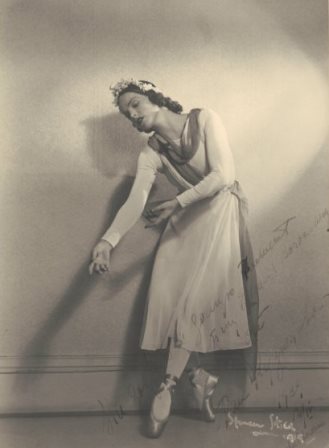A new comment on one of my earlier posts about the Dandré-Levitoff Russian Ballet tour of 1934–1935, which included Australia as well as South Africa, Indonesia and other locations, set me thinking about Raisse Kouznetsova and her Polish colleague Valery Shaievsky. The comment, which I thought came from Poland but I was wrong, indicated that Kouznetsova had married Shaievsky in 1927 and questioned why Hirsch was being used with her name. The comment is currently the last one at this link.

When the Dandré-Levitoff Russian Ballet arrived in Cape Town on 14 May 1934 to begin the South African leg of its tour, a passenger list for RMS Kenilworth Castle, the ship on which the company travelled from London to South Africa, appeared the following day in the Cape Times. A ‘Mrs R Kuxnetzova-Hirsch’ (sic) appeared on that list. A few months later, the company arrived in Brisbane to begin their appearances in Australia. Immigration records held in the National Archives of Australia list a ‘Raissa Hirsch’, born 1907 of Russian nationality, arriving in Brisbane on board the Nieuw Holland (the ship on which the company travelled to Australia from Bali) on 8 October 1934.
Although throughout Australia, for performances by the Dandré-Levitoff Russian Ballet and later with the Ballets Russes companies and then the Polish Australian Ballet, the name Hirsch appears not to have been used with Kouznetsova, or indeed used alone, what is puzzling is that Australian immigration records usually reflect passport details. I have always assumed that Kouznetsova was married to someone by the name of Hirsch when she arrived in Australia and I have idly speculated (to myself until now) that perhaps this was Georges Hirsch (1895–1974). Hirsch was administrator of the Réunion des théâtres lyriques nationaux in Paris during the 1940s and 1950s, although I have not yet discovered anything of his earlier career or whereabouts. The situation reminded me a little of that of Nina Verchinina-Chase’s marriage. I am wary of accepting the statement found in the entry on Kouznetsova on the National Library’s search engine Trove that Kouznetsova’s ‘real name’ was Raisse Hirsch. And was she even a Pole as many writers have stated? As for the date of her marriage to Shaievsky, Tamara Tchinarova, in her biography Dancing into the unknown, intimates that Kouznetsova and Shaievsky were married sometime after 1940.
Clarification of these mysteries is not helped by the many and varied spellings of the names (given and otherwise) of the protagonists! But clearly there remains a lot of investigation to be done.
Michelle Potter, 27 September 2014
Update: The story gets more complicated. More comments at the earlier post.
Your kind help with my Thadee Slavinsky inquiries have allowed me to gain a wealth of information on his rather interesting and somewhat mixed fortunes with Ballets Russes. At present we are still awaiting receipt of more precise information on aspects of his apparent demise in 1945 so I have nothing to enlighten you upon as yet. Whilst engaged in this enquiry a couple of other things have perked my interest including for instance the sad case of the American ballerina Mira Dimina and I wonder why she was interred in Adelaide prior to her mother’s imminent arrival. One would have thought that J. C. Williamson could have arranged for her remains to be sent back home and there are hints of their miserly treatment of performers at an individual level at least. I also wonder if there are instances of performers quiting their contracts and disappearing from the scene altogether during say the late 1940s. I’m also thinking that so many of these talented people coming from differing language groups must have had all sorts of problems communicating with their management and indeed with each other. Were they required to learn a common tongue like Esperanto eg or did they just struggle along. I note that people such as Leon Woizikowski did not speak English so well but seemed not perturbed and was successfull nevertheless. Thanks again for your help and I’ll keep you posted on any new information that may come to hand. Cheers
John, your query about Mira Dimina (Madeleine Parker) is an interesting one. She had been ill for a while and was hospitalised in Adelaide while the Monte Carlo Russian Ballet was performing there in October 1936. She died on 22 November 1936, by which time the company had gone on to Melbourne. Arnold Haskell has a chapter on Dimina/Parker in his book Dancing round the world but he doesn’t really address the question you asked, other than say that her mother had left on ‘a slow boat’ immediately the doctor had come to his conclusion that she was dangerously ill, when presumably her mother was informed. Air travel in 1936? I imagine it was not a common way to get to Australia. Haskell and three members of the company went to Adelaide (by train) immediately they heard the news of her death. According to Haskell the Adelaide manager for the Williamson organisation made the funeral arrangements. I guess someone had to make a decision. Perhaps it was the wrong one, we don’t know all the circumstances.
As for Esperanto, I have never heard that it was used!! French may have been something of a common language perhaps? I suspect, however, that they tended to stay within their ethnic/language groups a fair bit and struggled along in other circumstances.
I look forward to hearing more of your discoveries re Slavinsky.